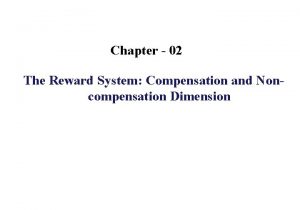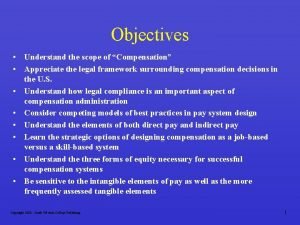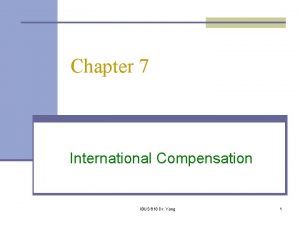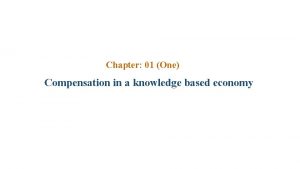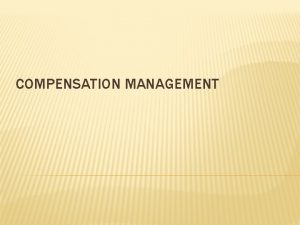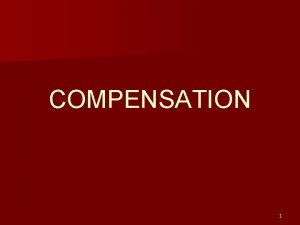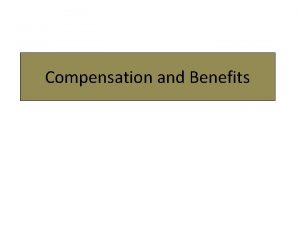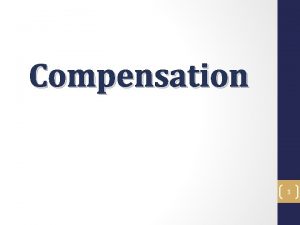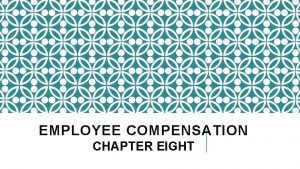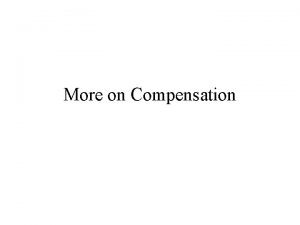Compensation Management Spirit of HR in Compensation Management


















- Slides: 18

Compensation Management Spirit of HR. in

Compensation Management �“If you pick the right people and give them the opportunity to spread their wings – and put compensation and rewards as a carrier behind it – you almost don’t have to manage them. ” -Jack Welch �Employee compensation: It is the remuneration received by an employee in return for his/her contribution to the organisation. Where remuneration = Monetary & Non Monetary Benefits �In other words it is the sum total of financial returns plus tangible services & benefits which an employee receives as a part of an employment contract.

Compensation Management Compensation Objective �To attract, retain & motivate employees �To pay establish a fair and equitable remuneration within the organisation. �To establish different levels of salary based on the roles and responsibilities �To pay salaries that are competitive within the industry �To comply with legal rules

Wage concepts and principles �Wage and salary plans and policies should be sufficiently flexible �Job evaluation must be done scientifically �Wage and salary administration plans must always be consistent with overall organizational plans and programs �Wage and salary administration programs should be in conformity with the social and economic objectives of the country like attainment of equality in income distribution and inflationary trends �Wage and salary administration plans and programs should be responsive to the changing local and national conditions.

Basic Factors in Pay Rates Determination �Organization's ability to pay �Supply and demand of labour �Government rules and regulations �Prevailing Market Rate �Cost of living �Productivity �Trade Unions bargaining power �Culture & Values of the organisation �Psychological and Social Factors

Job Evaluation � This is done by ranking the jobs in order to find out the relative worth of the job. Steps in Job Evaluation � Select the group of jobs e. g. workmen/staff/ supervisory/ managerial � Study the job analysis � Prepare the job description � For each job identify the key factors, give weightage to each factors. Each factor is divided into degree. This constitutes the job evaluation plan. � Grade the jobs based on the point given to each job. Then the jobs are classified into different grades. � Convert the job grades to money value with wage survey ( Broad banding) � Obtain the approval of union & management

Three Techniques of Wage Fixation 1. Individual Incentive System: �Time Wage Plan : The wages are paid according to the time spent by workers irrespective of his output of work done. The wage rate is fixed for an hour, day or month. �Piece Wage Plan: The wages are paid based on the output and not on the time. A fixed rate is paid for each unit produced, job completed or an operation performed. �Incentive Plan: This is applicable on the extra work performed apart and achievement of the fixed target as agreed during the fixing the performance goals for the next year during appraisal period.

Three Techniques of Wage Fixation 2. Group Incentive System: In this case the productivity is seen a group level. This system has been designed to foster performance in situations where team work is vital and interdependence on each other is high. Scanlon and Rucker Plan are the popular group incentive systems. 3. Fringe Benefits: These are non monetary benefits for the employees and their family given voluntarily by the employer. It includes welfare benefits, health, safety, security provisions, social security measures, medical, canteen facility, retirement benefits etc.

Elements of compensation Base salary is a fixed amount of money paid to an employee by an employer in return for work performed Variable pay-Variable pay is compensation that is contingent on discretion, performance or results which may vary in amount from period to period. Other names for variable pay include: incentive compensation, incentives, bonuses, commissions, cash awards and lump sums Fringe benefits - A collection of various benefits provided by an employer, which are exempt from taxation as long as certain conditions are met. It may include health insurance, group term life coverage, education reimbursement, childcare and assistance reimbursement, employee discounts, personal use of a company owned vehicle health insurance, pension plans, and paid vacations.

Wage and salary policies in India Base salary is a fixed amount of money paid to an employee by an employer in return for work performed Variable pay-Variable pay is compensation that is contingent on discretion, performance or results which may vary in amount from period to period. Other names for variable pay include: incentive compensation, incentives, bonuses, commissions, cash awards and lump sums Fringe benefits - A collection of various benefits provided by an employer, which are exempt from taxation as long as certain conditions are met. It may include health insurance, group term life coverage, education reimbursement, childcare and assistance reimbursement, employee discounts, personal use of a company owned vehicle health insurance, pension plans, and paid vacations.

Govt. Of India initiatives – Wage Administration �Equal Remuneration Act: It prohibits any discrimination of remuneration paid on the basis of gender or religion �Maternity benefit Act: This act allows payment of wages to women employees in maternity leave. Wages can’t be put on hold during the maternity leave period neither any termination nor suspension is possible during such leave. �Pay Commission: Wages and allowance of central and state government employees are determined through the pay commission appointed by the government.

Govt. Of India initiatives – Wage Administration �Payment of Wages Act : the objective of the act is to prohibit any delay or holding of wages which is due to employees �Industrial Dispute Act: This act authorizes all state governments to set up industrial tribunals which would look into disputes relating to remuneration. �Minimum Wages Act: This act aims at fixation of minimum wages to workers which will vary according to the standard of living statewise, category of employees wise in any industry.

Establishment of Pay Rates � Decide the Compensation Objectives (Attract, Retain, Motivate) � Internal Alignment Ø Internal Equity – Pay comparison within the hierarchy in the same organisation Ø Individual Equity – Pay comparison within the same level of job based on the degree of contribution to the business � External Alignment - Pay comparison with the competitor’s i. e. External Equity Ø The external alignment will make an employer decide the pay mix/ pay structure, the various forms of payment & how much to pay keeping in mind to attract, retain & motive employees � Employee Contribution Ø Pay for performance Ø Pay for seniority Ø Pay for Team based Ø Corporate Profit sharing

Establishment of Pay Rates Strategy at 3 levels � Strategy in complete Macro Environment i. e. different business, different customers, different talent pool For E. g. . (Google/ SBI/NTPC/Birla/Tata) � Strategy within the same industry ( IBM/TCS/HCL/WIPRO) � Strategy within same company ( Corporate office vs. business units/support functions vs. line functions) Compensation Aligned to Business Strategy � Innovator – Reward for innovations on products & services � Cost Centric – Focus on variable pay � Customer Centric – Incentive for customer satisfaction � Growth – very aggressive bonus, competitive base pay � People as Asset – ESOP, Unique benefits including family members

Pricing Managerial and Professional Jobs Compensation for a company’s top executives usually consists of four main elements � Base pay � Short term incentives � Long term incentive � Executive benefits and perks. � Base pay includes the person’s fixed salary as well as, often guaranteed bonuses such as 10% of pay at the end of the fourth fiscal quarter, regardless of whether or not the company makes a profit. � Short term incentives are usually cash or stock bonuses for achieving short terms goals, such as year to year increase in sales revenue. � Long term incentives aim to encourage the executive to take actions that drive up the value of the company’s stock, and include things like stock options; these generally give the executive the right to purchase stock at a specific price for a specific period. � Executive benefits and perks might include supplemental executive retirement pension plans, supplemental life insurance and health insurance without a deductible or coinsurance.

Determination of Executive Pay � The traditional wisdom is that company size and performance significantly affects top managers’ salaries. Studies show that company size and company performance explain only about 30% of the variation in CEO pay. � In reality CEO pay is set by the board taking into account a variety of factors such as the business strategy, corporate trends and most importantly where they want to be in a short and long term. � Another study concluded that CEOs pay depends on the complexity and unpredictability of the decisions they make. In this study, complexity was a function of such things as the number of businesses controlled by the CEO’s firm, the number of corporate officers in each firm, and the level of R&D and capital investment activity. � In practice CEOs may have considerable influence over the boards of directors who theoretically set their pay.

Elements of Executive Pay �Salary is traditionally the cornerstone of executive compensation it’s element on which employers layer benefits, incentives and perquisites – all normally conferred in proportion to base pay. �Executive compensation emphasizes performance incentives more than do other employees’ pay plans, since organizational results are likely to reflect executives’ contributions more directly than lower echelon employees.

THANK YOU Spirit of HR. in
 Come holy spirit dove divine
Come holy spirit dove divine Spirit spirit of gentleness
Spirit spirit of gentleness Noncompensation
Noncompensation Objectives of compensation cum reward system
Objectives of compensation cum reward system Scope of compensation
Scope of compensation Components of international compensation
Components of international compensation Classü
Classü Spirit of the arrow booklets
Spirit of the arrow booklets Faithfulness spirit and truth in translation
Faithfulness spirit and truth in translation Touching spirit bear at oow
Touching spirit bear at oow Touching spirit bear chapter questions and answers
Touching spirit bear chapter questions and answers Touching spirit bear chapter 19
Touching spirit bear chapter 19 Touching spirit bear chapter 20 questions and answers
Touching spirit bear chapter 20 questions and answers Israelfreespirit
Israelfreespirit Fruit of the spirit gentleness lesson
Fruit of the spirit gentleness lesson The spirit of reform lesson 1
The spirit of reform lesson 1 9 spiritual gifts
9 spiritual gifts The lord is here his spirit is with us
The lord is here his spirit is with us Https://ihtusa.com/
Https://ihtusa.com/


